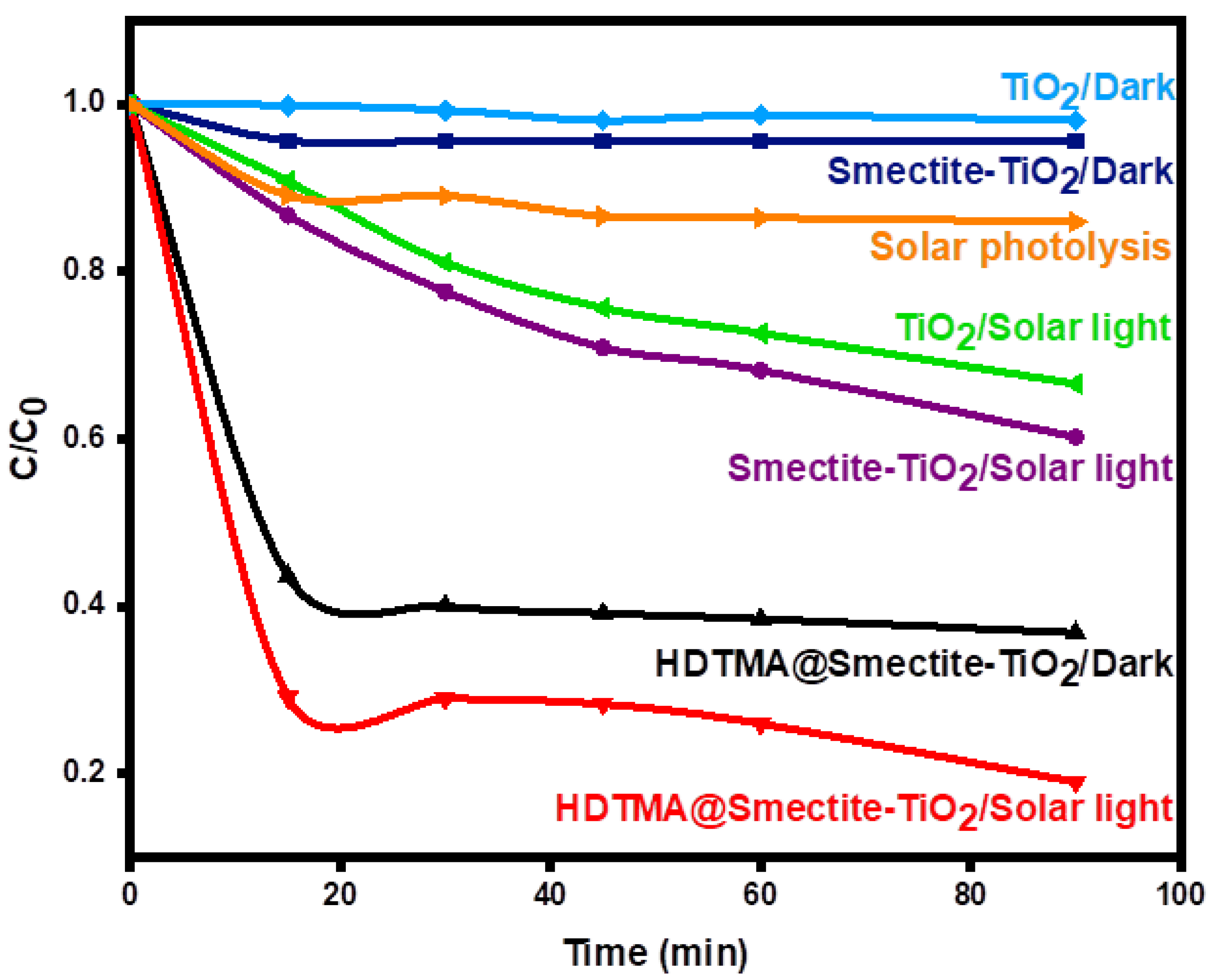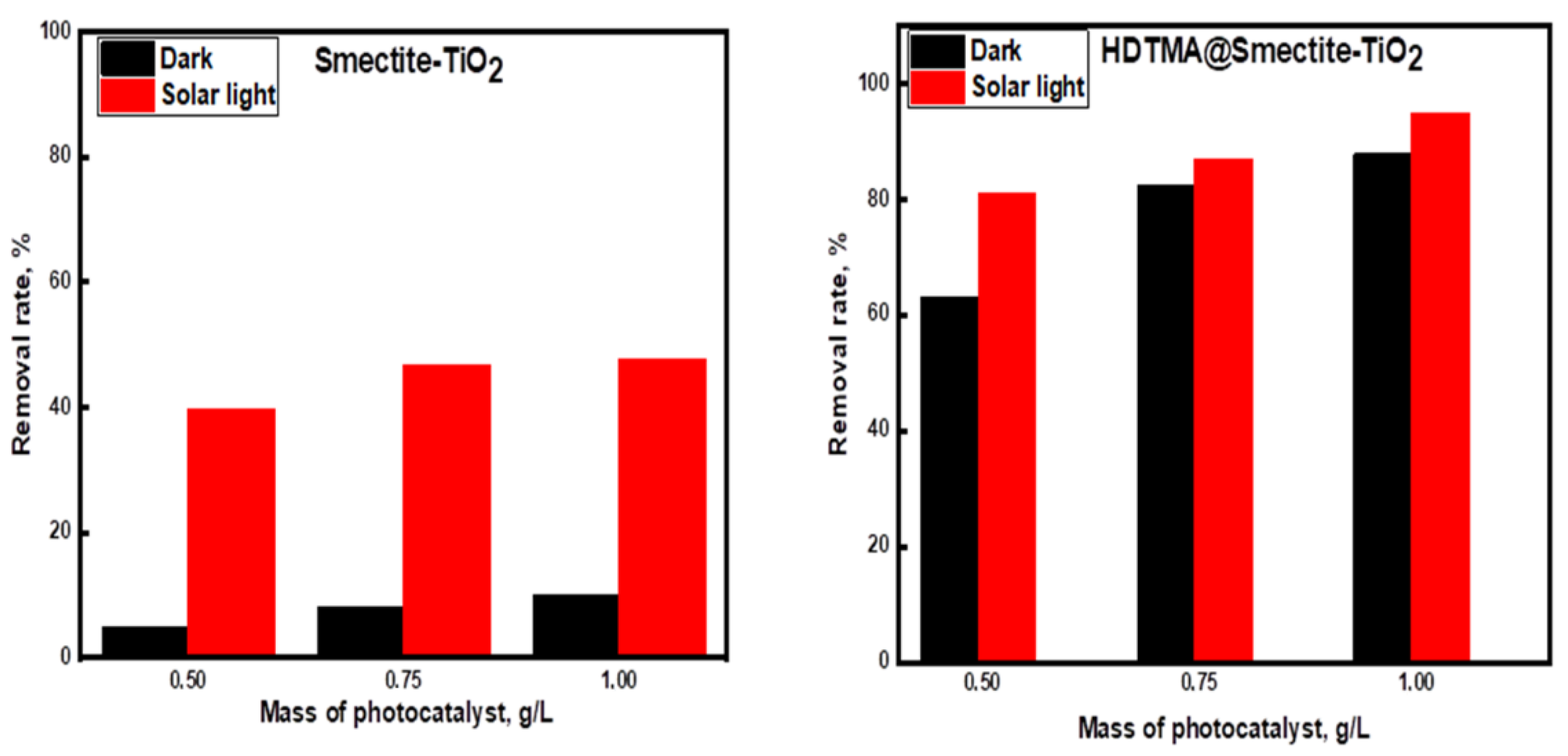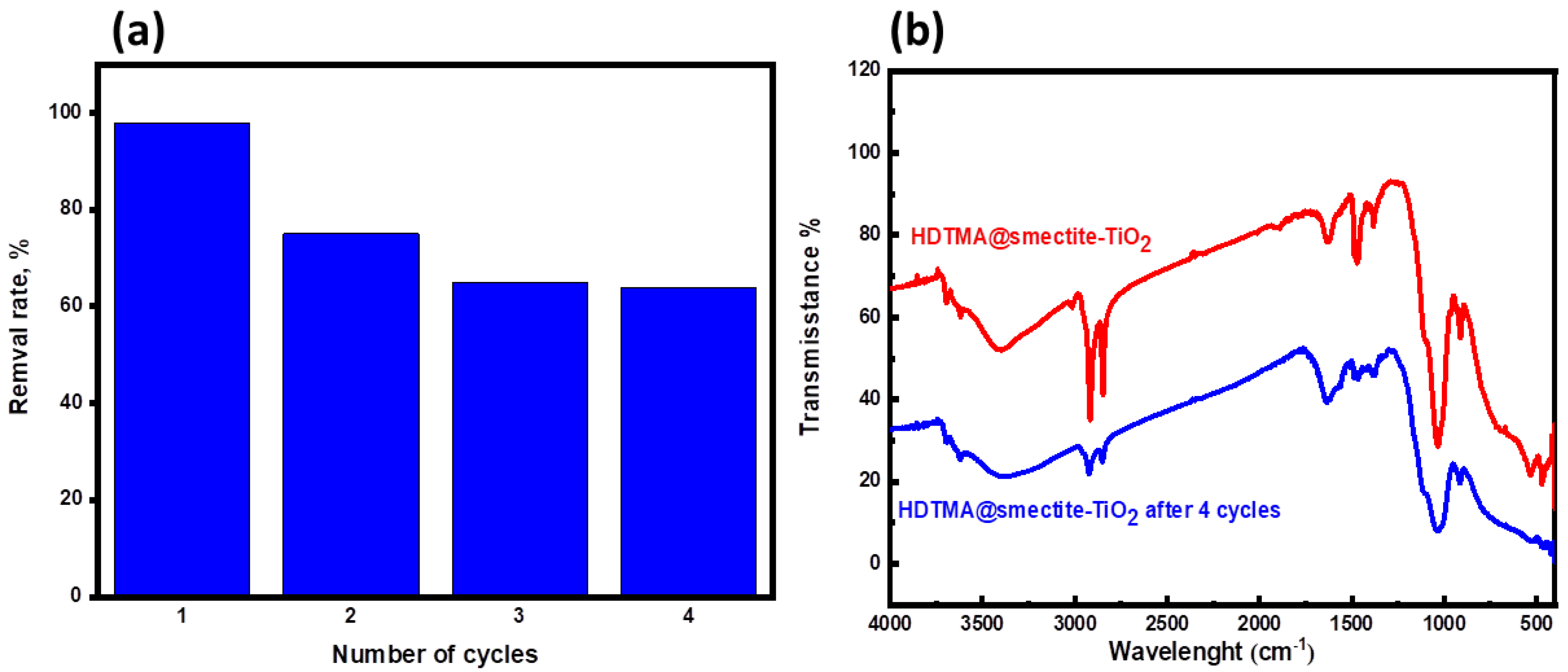Enhanced Photocatalytic Kinetics Using HDTMA Coated TiO2-Smectite Composite for the Oxidation of Diclofenac under Solar Light
Abstract
1. Introduction
2. Results and Discussion
2.1. Characterization
2.2. Photocatalytic Activity
2.2.1. Control Experiments
2.2.2. Effect of Photocatalyst Mass
2.2.3. Effect of Initial Concentrations and Kinetics
2.2.4. Recycling Tests
3. Materials and Methods
3.1. Synthesis of Photocatalysts
3.2. Characterization of Materials
3.3. Photocatalytic Test
4. Conclusions
Author Contributions
Funding
Data Availability Statement
Conflicts of Interest
References
- Patneedi, C.B.; Prasadu, K.D. Impact of pharmaceutical wastes on human life and environment. Rasayan J. Chem. 2015, 8, 67–70. [Google Scholar]
- Chander, V.; Sharma, B.; Negi, V.; Aswal, R.S.; Singh, P.; Singh, R.; Dobhal, R. Pharmaceutical compounds in drinking water. J. Xenobiotics 2016, 6, 5774. [Google Scholar] [CrossRef]
- Djellabi, R.; Giannantonio, R.; Falletta, E.; Bianchi, C.L. SWOT analysis of photocatalytic materials towards large scale environmental remediation. Curr. Opin. Chem. Eng. 2021, 33, 100696. [Google Scholar] [CrossRef]
- Loeb, S.K.; Alvarez, P.J.; Brame, J.A.; Cates, E.L.; Choi, W.; Crittenden, J.; Dionysiou, D.D.; Li, Q.; Li-Puma, G.; Quan, X. The Technology Horizon for Photocatalytic Water Treatment: Sunrise or Sunset? Environ. Sci. Technol. 2019, 53, 2937–2947. [Google Scholar] [CrossRef]
- Djellabi, R.; Bianchi, C.L.; Haider, M.R.; Ali, J.; Falletta, E.; Ordonez, M.F.; Bruni, A.; Sartirana, M.; Geioushy, R. Photoactive Polymer for Wastewater Treatment. In Nanomaterials for Water Treatment and Remediation; CRC Press: Boca Raton, FL, USA, 2021; pp. 217–244. [Google Scholar]
- Djellabi, R.; Ordonez, M.F.; Conte, F.; Falletta, E.; Bianchi, C.L.; Rossetti, I. A review of advances in multifunctional XTiO3 perovskite-type oxides as piezo-photocatalysts for environmental remediation and energy production. J. Hazard. Mater. 2022, 421, 126792. [Google Scholar] [CrossRef]
- Ameta, R.; Solanki, M.S.; Benjamin, S.; Ameta, S.C. Photocatalysis. In Advanced Oxidation Processes for Waste Water Treatment; Elsevier: Amsterdam, The Netherlands, 2018; pp. 135–175. [Google Scholar]
- Spasiano, D.; Marotta, R.; Malato, S.; Fernandez-Ibanez, P.; Di Somma, I. Solar photocatalysis: Materials, reactors, some commercial, and pre-industrialized applications. A comprehensive approach. Appl. Catal. B Environ. 2015, 170, 90–123. [Google Scholar] [CrossRef]
- Djellabi, R.; Ghorab, M. Solar photocatalytic decolourization of crystal violet using supported TiO2: Effect of some parameters and comparative efficiency. Desalination Water Treat. 2015, 53, 3649–3655. [Google Scholar] [CrossRef]
- Nah, Y.C.; Paramasivam, I.; Schmuki, P. Doped TiO2 and TiO2 nanotubes: Synthesis and applications. ChemPhysChem 2010, 11, 2698–2713. [Google Scholar] [CrossRef]
- Zaleska, A. Doped-TiO2: A review. Recent Pat. Eng. 2008, 2, 157–164. [Google Scholar] [CrossRef]
- Sadowski, R.; Wach, A.; Buchalska, M.; Kuśtrowski, P.; Macyk, W. Photosensitized TiO2 films on polymers–Titania-polymer interactions and visible light induced photoactivity. Appl. Surf. Sci. 2019, 475, 710–719. [Google Scholar] [CrossRef]
- Djellabi, R.; Yang, B.; Xiao, K.; Gong, Y.; Cao, D.; Sharif, H.M.A.; Zhao, X.; Zhu, C.; Zhang, J. Unravelling the mechanistic role of TiOC bonding bridge at titania/lignocellulosic biomass interface for Cr (VI) photoreduction under visible light. J. Colloid Interface Sci. 2019, 553, 409–417. [Google Scholar] [CrossRef]
- Pandey, S.; Shukla, A.; Tripathi, A. Effect of pressure on electrical and optical properties of metal doped TiO2. Opt. Mater. 2022, 133, 112875. [Google Scholar] [CrossRef]
- Hamrouni, A.; Azzouzi, H.; Rayes, A.; Palmisano, L.; Ceccato, R.; Parrino, F. Enhanced solar light photocatalytic activity of ag doped TiO2–Ag3PO4 composites. Nanomaterials 2020, 10, 795. [Google Scholar] [CrossRef]
- Ajmal, Z.; Naciri, Y.; Ahmad, M.; Hsini, A.; Bouziani, A.; Laabd, M.; Raza, W.; Murtaza, A.; Kumar, A.; Ullah, S. Use of Conductive Polymer-Supported Oxide-based Photocatalysts for Efficient VOCs & SVOCs Removal in Gas/Liquid Phase. J. Environ. Chem. Eng. 2022, 11, 108935. [Google Scholar]
- Tsebriienko, T.; Popov, A.I. Effect of poly (titanium oxide) on the viscoelastic and thermophysical properties of interpenetrating polymer networks. Crystals 2021, 11, 794. [Google Scholar] [CrossRef]
- Volfkovich, Y.M.; Rychagov, A.Y.; Sosenkin, V.E.; Baskakov, S.A.; Kabachkov, E.N.; Shulga, Y.M. Supercapacitor Properties of rGO-TiO2 Nanocomposite in Two-component Acidic Electrolyte. Materials 2022, 15, 7856. [Google Scholar] [CrossRef]
- Bortolotto, V.; Djellabi, R.; Giordana, A.; Cerrato, G.; Di Michele, A.; Bianchi, C.L. Photocatalytic behaviour of Ag3PO4, Fe3O4 and Ag3PO4/Fe3O4 heterojunction towards the removal of organic pollutants and Cr (VI) from water: Efficiency and light-corrosion deactivation. Inorg. Chem. Commun. 2022, 141, 109516. [Google Scholar] [CrossRef]
- Shah, J.H.; Fiaz, M.; Athar, M.; Ali, J.; Rubab, M.; Mehmood, R.; Jamil, S.U.U.; Djellabi, R. Facile synthesis of N/B-double-doped Mn2O3 and WO3 nanoparticles for dye degradation under visible light. Environ. Technol. 2019, 41, 2372–2381. [Google Scholar] [CrossRef]
- Djellabi, R.; Fouzi Ghorab, M.; Smara, A.; Bianchi, C.L.; Cerrato, G.; Zhao, X.; Yang, B. Titania–Montmorillonite for the photocatalytic removal of contaminants from water: Adsorb & shuttle process. In Green Materials for Wastewater Treatment; Springer: Berlin/Heidelberg, Germany, 2020; pp. 291–319. [Google Scholar]
- Saber, A.N.; Djellabi, R.; Fellah, I.; Abderrahim, N.; Bianchi, C.L. Synergistic sorption/photo-Fenton removal of typical substituted and parent polycyclic aromatic hydrocarbons from coking wastewater over CuO-Montmorillonite. J. Water Process Eng. 2021, 44, 102377. [Google Scholar] [CrossRef]
- Abderrahim, N.; Djellabi, R.; Amor, H.B.; Fellah, I.; Giordana, A.; Cerrato, G.; Di Michele, A.; Bianchi, C.L. Sustainable purification of phosphoric acid contaminated with Cr (VI) by Ag/Ag3PO4 coated activated carbon/montmorillonite under UV and solar light: Materials design and photocatalytic mechanism. J. Environ. Chem. Eng. 2022, 10, 107870. [Google Scholar] [CrossRef]
- Fellah, I.; Djellabi, R.; Amor, H.B.; Abderrahim, N.; Bianchi, C.L.; Giordana, A.; Cerrato, G.; Di Michele, A.; Hamdi, N. Visible light responsive heterostructure HTDMA-BiPO4 modified clays for effective diclofenac sodium oxidation: Role of interface interactions and basal spacing. J. Water Process Eng. 2022, 48, 102788. [Google Scholar] [CrossRef]
- Djellabi, R.; Yang, B.; Sharif, H.M.A.; Zhang, J.; Ali, J.; Zhao, X. Sustainable and easy recoverable magnetic TiO2-Lignocellulosic Biomass@ Fe3O4 for solar photocatalytic water remediation. J. Clean. Prod. 2019, 233, 841–847. [Google Scholar] [CrossRef]
- Djellabi, R.; Ghorab, M.; Cerrato, G.; Morandi, S.; Gatto, S.; Oldani, V.; Di Michele, A.; Bianchi, C. Photoactive TiO2–montmorillonite composite for degradation of organic dyes in water. J. Photochem. Photobiol. A Chem. 2014, 295, 57–63. [Google Scholar] [CrossRef]
- Rezende, J.; Ramos, V.; Oliveira, H.; Oliveira, R.M.P.B.; Jesus, E. Removal of Cr (VI) from aqueous solutions using clay from Calumbi geological formation, N. Sra. Socorro, SE State, Brazil. In Materials Science Forum; Trans Tech Publications Ltd.: Bäch, Switzerland, 2018; pp. 1–6. [Google Scholar]
- Djellabi, R. Contribution de la Photocatalyse à l’élimination des Polluants Industriels. Ph.D. Thesis, Universite Badji Mokhtar, Annaba, Algeria, 2015. [Google Scholar]
- Dinh, V.-P.; Nguyen, P.-T.; Tran, M.-C.; Luu, A.-T.; Hung, N.Q.; Luu, T.-T.; Kiet, H.T.; Mai, X.-T.; Luong, T.-B.; Nguyen, T.-L. HTDMA-modified bentonite clay for effective removal of Pb (II) from aqueous solution. Chemosphere 2022, 286, 131766. [Google Scholar] [CrossRef]
- Hui, K.C.; Ang, W.L.; Yahya, W.Z.N.; Sambudi, N.S. Effects of nitrogen/bismuth-doping on the photocatalyst composite of carbon dots/titanium dioxide nanoparticles (CDs/TNP) for enhanced visible light-driven removal of diclofenac. Chemosphere 2022, 290, 133377. [Google Scholar] [CrossRef]
- Meroni, D.; Djellabi, R.; Ashokkumar, M.; Bianchi, C.L.; Boffito, D.C. Sonoprocessing: From concepts to large-scale reactors. Chem. Rev. 2021, 122, 3219–3258. [Google Scholar] [CrossRef]






Disclaimer/Publisher’s Note: The statements, opinions and data contained in all publications are solely those of the individual author(s) and contributor(s) and not of MDPI and/or the editor(s). MDPI and/or the editor(s) disclaim responsibility for any injury to people or property resulting from any ideas, methods, instructions or products referred to in the content. |
© 2022 by the authors. Licensee MDPI, Basel, Switzerland. This article is an open access article distributed under the terms and conditions of the Creative Commons Attribution (CC BY) license (https://creativecommons.org/licenses/by/4.0/).
Share and Cite
Fellah, I.; Djellabi, R.; Ben Amor, H.; Hamdi, N.; Ordonez, M.F.; Bianchi, C.L. Enhanced Photocatalytic Kinetics Using HDTMA Coated TiO2-Smectite Composite for the Oxidation of Diclofenac under Solar Light. Catalysts 2023, 13, 51. https://doi.org/10.3390/catal13010051
Fellah I, Djellabi R, Ben Amor H, Hamdi N, Ordonez MF, Bianchi CL. Enhanced Photocatalytic Kinetics Using HDTMA Coated TiO2-Smectite Composite for the Oxidation of Diclofenac under Solar Light. Catalysts. 2023; 13(1):51. https://doi.org/10.3390/catal13010051
Chicago/Turabian StyleFellah, Imen, Ridha Djellabi, Hédi Ben Amor, Noureddine Hamdi, Marcela Frias Ordonez, and Claudia L. Bianchi. 2023. "Enhanced Photocatalytic Kinetics Using HDTMA Coated TiO2-Smectite Composite for the Oxidation of Diclofenac under Solar Light" Catalysts 13, no. 1: 51. https://doi.org/10.3390/catal13010051
APA StyleFellah, I., Djellabi, R., Ben Amor, H., Hamdi, N., Ordonez, M. F., & Bianchi, C. L. (2023). Enhanced Photocatalytic Kinetics Using HDTMA Coated TiO2-Smectite Composite for the Oxidation of Diclofenac under Solar Light. Catalysts, 13(1), 51. https://doi.org/10.3390/catal13010051







